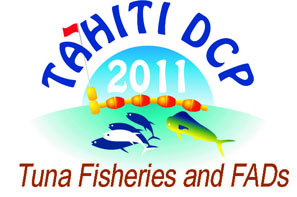Fish aggregating devices (FADs) in the Gulf of Thailand are made of bamboo poles, twisted wire and coconut leaves, and fastened to a concrete block. Purse seines with 2.5 cm mesh size are used to surround the fish by fishing boats ranging from 18-28 m overall length. Fishing grounds are in the central Gulf of Thailand at the depth of 25-60 m. Catch per unit effort (CPUE), species composition and size of economically important species were analyzed by collecting the data from fishing boats using FADs at six main fishing ports along the Gulf of Thailand during January-December 2007. The results show that average CPUE was 3,351.36 kg day-1 which composed of 88.07% pelagic fishes, 5.13% demersal fishes, 4.33% trash fishes and 2.47% squids and cuttlefishes. The major pelagic species were Indian mackerel (Rastrelliger kanagurta), Indian scad (Decapterus russelli) and bigeye scad (Selar crumenophthalmus) which were 25.37%, 23.65% and 8.24% of total catch respectively while small tunas (kawakawa; Euthynnus affinis, frigate tuna; Auxis thazard thazard and longtail tuna; Thunnus tonggol) were 8.26% of total catch. The mean length of 10 economically important species were smaller than size at first maturity while 2 species were larger than size at first maturity. The results indicated that juvenile fish were largely caught by FADs fishery which may led to fisheries resources depletion and loss in economy. Although there is a set of measures to control the use of purse seines, effective management of the FADs capacity is urgently needed also.
 |
This conference aims to take stock of the exploitation of large pelagic fish using anchored and drifting FADs in the world.
28 Nov-2 Dec 2011 Arue (French Polynesia)
|
|
Tuesday
29
2- Industrial fisheries on moored and drifting FADs
› 16:10 - 16:30 (20min) › Endeavour
FADs fishery in the Gulf of Thailand: time to manage
1 : Asian Institute of Technology
(AIT)
P.O. Box 4, Klong Luang, Pathum Thani 12120, Thailand -
Thaïlande
2 : Eastern Marine Fisheries Research and Development Center
2 Phe, Muang, Rayong 21160 -
Thaïlande
3 : Chumphon Marine Fisheries Research and Development Center
408 Paknam, Muang, Chumphon 86120 -
Thaïlande
4 : Southern Marine Fisheries Research and Development Center
79/1 Wichianchom Rd., Bo-yang, Muang, Songkhla 90000 -
Thaïlande
5 : Asian Institute of Technology
* : Corresponding author
P.O. Box 4, Klong Luang, Pathum Thani 12120 -
Thaïlande
|
 PDF version
PDF version
